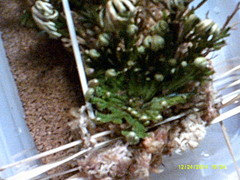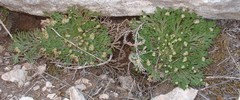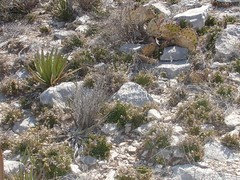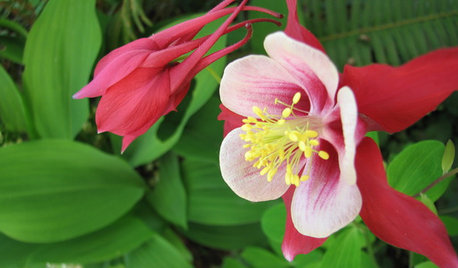Has anyone ever tried to grow a Resurrection Plant?
Over the years I've seen many ads for "Resurrection Plants," and I've always thought the claims sounded too good to be true. Yesterday, my aunt gave me one that she'd had, dry, for "a few years." It was about the size and shape of a medium chicken egg, and was a moderately dark brown color. Since the ads I've recently seen claim the plant can be left dry for 50 years with no problem, I went ahead and placed it in a shallow bowl of water. Within minutes it started to absorb water and expand, and after two hours it was fully wet and laying mostly flat. When it stopped expanding, it was a little over 5 inches wide. However, it was also still brown. Now, the ads say that it can go "from a dry, lifeless ball to a lush green fern in 3 hours," but 22 hours later mine is still brown.
A quick search of GardenWeb lead to a post from 2004 which said that "the ones you find for sale are very likely to already be dead," and I think that mine's dead, too. Is there any chance that it will "green up" and come back to life, or should I just take it out of the water and let it dry back out, to keep as a "novelty"?
I found this picture through a Google search, and it looks a lot like mine did when dry, only larger...
{{gwi:103653}}
Here is a link that might be useful: Interesting article on Resurrection Plant
Comments (33)
nanw_4wi
15 years agoI tried this one before.
It is very intriguing, watching it 'sort of' come back to life....but mine stayed quite brown in some areas, too.I have seen photos of other's plants, however, that were beautiful completely green plants!
I thought maybe it was our water, so I tried it in distilled water....still more brown than I hoped for.
So, I guess all I can say is that my experience with it was similar to yours.
Maybe it does depend on it's age or something...I could never figure it out!
Oklahoma_Tim
Original Author15 years agoYes, I guess that my plant was too old to be "resurrected!" I went ahead and took it out of the water last night, since it hadn't shown any signs of life after 32 hours. By this afternoon it was mostly dry, but only partially curled back up. I doubt that it will curl back up into a ball, but it's still an interesting little conversation piece.
Has anyone else tried to grow one of these things? Is it better to use distilled water, or is tap water okay? I'm thinking about trying to buy some new ones, since I recently saw an ad for "buy one get one free" for $10, plus $5 shipping--that's two plants for $15. Is it worth the money?
Related Professionals
Prairie Ridge Landscape Architects & Landscape Designers · Wheeling Landscape Architects & Landscape Designers · Bell Gardens Landscape Contractors · Elmhurst Landscape Contractors · Fuquay-Varina Landscape Contractors · Hendersonville Landscape Contractors · Middleton Landscape Contractors · Monterey Landscape Contractors · Mount Sinai Landscape Contractors · New Cassel Landscape Contractors · Oakland Landscape Contractors · Ringwood Landscape Contractors · Wailuku Landscape Contractors · Oxon Hill Landscape Contractors · Maple Heights Landscape Contractorsamccour
15 years agoIt sounds like the brown tissues is sort of dead and won't green-up, but will start putting out new green growth.
I like lycopodiophytes (Is that the correct term?). I'd like to set up a little vivarium with quillworts and spikemosses and clubmosses and the like in it. Except I can't find anyone selling clubmosses, I don't know if they grow around here and if they do, I don't know if they'd be a protected species or one that could be transplanted without killing it as some are more sensitive than others.
Selaginella's sold everywhere, though.
Oklahoma_Tim
Original Author15 years agoI'm pretty sure that my resurrection plant is dead, since it showed no signs of life after being in water for 32 hours. I did think about leaving it in there, though, to see if it wound start putting out new growth, but I didn't want it to start rotting. (BTW, it actually did curl back up into a ball, and I think I'd like to keep it that way.)
I'm still trying to decide whether or not to buy a new one, so I was hoping somebody on this forum had some experience with this type of Selaginella. You know, what kind of soil to use, or if they grow better in water, and if the ones sold through the mail are even likely to be alive or not.
amccour
15 years agoThis is interesting. Apparently, resurrection plants can also be something called a Rose of Jericho, which is an angiosperm. I guess the selaginella in your information link can also be called that, but that's obviously not an angioserm. Anyway, botanical name is Anastatica hierochuntica, and that's what I think YOU have.
http://en.wikipedia.org/wiki/Resurrection_plant
According to that, these don't actually come back to life, but just unfurl and disperse their seeds.
The selaginellas can apparently be dessicated and brought back to a growing state, as can resurrection ferns.
garyfla_gw
15 years agoHi
When I first saw the title I thought you were talking about resurrection fern which grows as an epiphyte at least in this part of florida. It culrs up and goes dormant until the rains return. I keep some in my shadehouse where it is always hydrated and rather surpised that the dormant state is not required. Grows all year long.
You are talking about a type of selaginella that is native to southern Texas??
I grow lots of tropical selags but none of this type.
This is among the worlds oldest type of plants and have adapted to all sorts of growing conditions.
My understanding is that the plants unfurls to diperse seed. Read an interesting article about plants in the Atacama desert that frequently go 50 years between cycles due to lack of rain. garyOklahoma_Tim
Original Author15 years agoYes, I think I've read somewhere that the plant I'm looking for, Selaginella lepidophylla, is native to the southernmost portions of the U.S. and into Mexico. I'm not sure if I was clear enough about exactly what I was looking for in my initial posting, so I've found a link to exactly the type of ad that I've been seeing lately.
Seriously, has anybody out there ever gotten one of these things to grow?????
Here is a link that might be useful: Ad for Resurrection Plant from British company
amccour
15 years agoGet a picture of yours when unfurled and wet, if possible. I know it was still dead, but it might be useful for figuring out what, specifically, you actually got as resurrection plant can refer to several things.
Oklahoma_Tim
Original Author15 years agoAll right, amccour, perhaps I still maven't made myself totally clear: I'm not looking for a plant i.d. The dead plant that I was given is a dead ringer (pun intended) for the plants in the pictures labelled "Sinningia lepidophylla" that I find through Google Image searches. Also, I couldn't post a picture of my plant even if I wanted to, since I don't have a digital camera.
I really don't mean to seem rude here, but I'm just trying to get my point across.
What I am looking for is advice on how to grow these elusive houseplants. . . .
amccour
15 years agoSorry.
I think your best bet is to by a plant in a non-dried-up state and don't let it go into that state. Even if they can survive like that for awhile, it'd be stressful. Also, I'm guessing most of the suppliers selling dried out one are more in the novelty business and don't care if the plants are alive.
I haven't grown Selaginella personally, but from my understanding, their requirements are fairly similar to ferns -- higher humidity, water when dry (although spikemosses might need to be kept on the wetter side), and I'm guessing filtered light.
skyzfuture_aol_com
15 years agoI figured out what happens. 1st of all the Anastatica hierochuntica is not the fern type plant from america, it's the one from the middle east which doesn't turn green really, but it has more religious history.
The american fern type one pictured above: in order to keep it from going brown you only keep it in water for a maximum of three days, then let it dry out for at least a week. The brown is caused by the water for some reason...mold or something... they're still "alive" after they're brown, but they don't smell right and just have a kinda dull vibration. I delt with this problem for years and finally figured it out.
For the reason I came here, to find out how to grow Anastatica hierochuntica from a seed, I didn't really find the answer, so I'm going to mix some potting soil with some sand and see what happens...
to get Anastatica hierochuntica look up "the real rose of jericho" the american fern type version though has its own merrits. I love both for different metaphysical reasons. It seems the actual rose of jericho must be brought to life much more seldomly... on christmas eve for example.
skydin
markworden
15 years agoI am very interested in seing the results of the post above by "sky". I have one of these plants that is quite green, and we love it. So much so that we would like to grow another one.
Please do let us know if you are able to "grow" a new one of these plants.
roblee927_gmail_com
13 years agoI have messed around with these. trying out all kinds of ways (lots of failures). My success came with my latest plant experiment. In a shallow bowl (mine is 3"),I layed in 1" of pebbles, then rwo inches of desert sand. I use water with a ph of 7.5, it is green and as of today it is 8"wide. This is about an 1.5" bigger than when I bought it.
Hope this is useful to you all
Lee Robertsjuggalo4187_yahoo_com
13 years agoYES i have played with them a bit and done time lapsed photos and enjoy them a lot! There are different types of them some are greener than others.The one i found to be the coolest and greenest was at jo-ans fabrics $9.99 ... i think it it a young plant with lava rocks and a bole bright green with city water no dirt nothing. i found the more you try to take care of them ( nice dirt clean water ect ) the worse they do i think they dont have the name of it but heres a link http://www.joann.com/joann/catalog/productdetail.jsp?pageName=search&flag=true&PRODID=xprd1132290 there on sale rt now to
amanda_nitsch_sbcglobal_net
13 years agoReserrection fern typically does not do well once you remove it from the place where it was growing. You can try using yogurt to keep it alaive. Sounds strange but that is how u propagate many types of mosses. Even though it is a fern it grows more like a moss
Kreutzkampf
12 years agoI have this "resurrection fern" (pleopeltis polypodiodes). A gift from a close friend and master of propagating all plant life and otherwise. If you are familiar: what do you think about mine having a leaf-mold? They are supposed to be antifungal and antibacterial to gram -/+ bacterias...?! Granted; it lived in a glass of pure water for weeks too long before I retuned to discover this occurence and promptly dehydrated it back to dormancy. Any advice? I'm waking it now to check the status but cannot yet tell if there's development or change. Is this natural, curable, or something more?
lynngun
9 years agoI have read that these plants and I found that there is a major point of confusion: at least for me. There are two kinds of these plants. Anastatica is native to the Middle East and it is disputed whether or not it comes back to life or just releases the seeds, according to Wikipedia. Selaginella lepidophylla is the plant that is commonly sold as a novelty plant. It is native to deserts on the U.S.A.--Mexico border.
When growing these plants it is recommended that you fill a shallow dish with gravel and then put a little bit of water in it. The Wikipedia page for Anastaticas states that a dead plant will still uncurl due to expanding cells. I recently received some Selaginella lepidophylla and they all seem green on the inside but brown on the out side.
I know this will be to late, but personally I would place the plant in the tray of wet gravel just to see if it might put out new growth. What is the worse that happens?
Have fun with your plant.
L.G.Here is a link that might be useful: Selaginella lepidophylla
emerald1951
9 years agohi all, I have been reading this post with much interest...I have one of these don't know where I got it but its called a 'dinasur plant' and I just put it in water, I don't know how old it is or where I got it, I remember my Mom having these, but I can't remember if they grew or what happened to them...lol...but my question to you all is, is this the little fern plant that is arround in stores now and they are called a snow fern, I always see them just before the holidays and they look a lot like these, the pictures in the links you all put on here, only they are planted and green with white tips, they are labled snow fern.....any ideas????
cooperdr_gw
9 years agoThis I got at a Mexican market in the herbal section. It said Doradilla and fem Scale on the label.

MrBlubs
9 years agoI too just recently got aÃÂ Selaginella lepidophylla
It's been in water and it has uncurled and is actually very green on the inside
I can't find much info on them but do you plant them? Or do you just keep them in water? Right now mine is in a pot filled with pebbles and water with just the very bottom of the plant actually in the water
Do I just keep it like this? Or I'm I suppose to plant it in some sort of media?
Very confused on it
Also what light does it need?cooperdr_gw
9 years agoLeaving it in water would just make it rot. I only wake mine up and then let it curl back up again. If you planted it might be happy but they're a kind of tumbleweed so it could roll away if it wasn't tied down somehow. Planting it indoors would kind of make it hard to take out of the water.
MrBlubs
9 years agoI guess that makes sense.... I'll try to plant it In most soil and see how it does. It was only 99 cents and free shipping so always could get like 5 more to experiment with
cooperdr_gw
9 years agoIt might work. I'm not really an expert on growing them. When I bought it I thought it was for cooking! Turns out you can make some kind of tea out of them but it's for some medical purpose like gall-stones or something.
savannaicus
9 years agoAfter learning of this plant from this post I went online and purchased two of them for $.99 each including shipping. They should be arriving sometime this week. I'm excited for them to arrive but not trying to get my hopes up in case I get a pair of duds. This plant is so neat!
MrBlubs
9 years agoHaha! Everytime I try to find information on them I always get to weird magic and spell sites and whatever.... Supposedly it's used to conjur spirits in Voodoo! ... Weird. There's lots of religiousness around it
Good luck with yours Savannaicus!Elsie Hopkins
7 years agoWhen I was in high school, my step father brought one home to me. I put it in water and revived it as a science project. it opened and greener up beautifully, then I removed it and let it dry up again. I recently ordered 4 plants and hope to revive them.
User
7 years agoHi. Stan here.
All right, let's put this puppy to rest. First, if you want to keep one of the "resurrection plants" alive, you need to figure out which resurrection plant you have. Here, I'm going to address ONLY the resurrection plant from the Chihuahua Desert, spanning several states in the southwestern USA and adjacent parts of Mexico. (If you have one of the other kinds of resurrection plants, you're on your own.)
Botanically, these plants are part of a much larger group called the club mosses. They fall somewhere between the mosses and the true ferns. They are a very old group of plants dating from the Coal Ages. Their scientific name is Selaginella lepidophylla. If you want to get it right, the "S" and only the "S" in Selaginella is ALWAYS capitalized, all other letters are lower case. And both words are italicized. (No italics on your typewriter? Then you can underline them instead.)
Almost all other Selaginella in the world are moist habitat plants, living in deep forests, swamps, in or near streams and creeks, or among other plants for protection from direct, scorching sunlight and desiccating dryness. You would grow them the way you grow most of the true mosses.
S. lepidophylla is a distinct exception, apparently surviving if not thriving in a desert, and a pretty severe one at that.
I am trying to include several photos I took of them growing in their native habitat in western Texas. Note that they most commonly grow on the northern sides of hills and protected in the shadows of rocks or other plants. If they receive any direct sun at all, it's only for a few hours in early morning and very late afternoon. They tend to grow where they're in dense shade throughout most of the day.
Note also that the soil in which they grow is comprised mostly of disintegrated, calcareous rock (i.e., limestone soil) with a little organic detritus (mostly naturally composted leaves, grasses, mosses, and other dead plants) mixed in. The limestone base is strongly alkaline, and the organic stuff tends to act as a hydrophilic buffer, holding water for a few precious hours or days after a dew or rain.
The climate in which they grow is fierce. In Summer the daytime temperatures often reach 100̊ F. They may receive a few drops of rain from time to time, BUT while the Chihuahua Desert does not receive a lot of moisture in the form of rain, it is often blessed with dense fogs and heavy dews. And these are the resurrection plants' saving grace.
Winters are a little less hostile. Nighttime temperatures often drop slightly below freezing, and light, freezing rain and sleet are not uncommon. For S. lepidophylla, life is a lot easier.
S. lepidophylla, much like other Selaginella, uses a collection of tine hairlike roots to hold itself in place in the desert, and to absorb what little liquid water might be available, but it probably gets most of its water from the aforementioned fogs, dews, and occasional rains as the water is absorbed directly through the surfaces of its leaves and stems. It almost never sits in liquid water for more than a few hours.
No, they are not immortal, and cannot survive forever in a dried state. In fact, if your S. lepidophylla isn't obviously fresh and alive when you get it, it probably never will be, regardless of what you do for it. All reports of them recovering after 50 years rolled into a brown ball are either circus hawkers' sales pitches, or statements by people who can't recognize a dead plant when they see one, and were fooled by the unfurling corpse. (At this point perhaps you should review the Monty Python "Dead Parrot" Sketch on YouTube.) How long can they survive in such a dried, dormant state? I don't know. Apparently no one has ever performed any sort of controlled experiments to determine this, and there is so much hogwash flying around about the matter that it's impossible to even make an educated guess.
So, how might you try keeping one alive? I confess I've never been successful, and I've only seen one botanical conservatory with living S. lepidophylla on display. And, I know of a veritable garden of them growing wild in the Chihuahua Desert of west Texas. Here are some suggestions based on general plant care, plant physiology, Botany, and what I've seen in the wild:
1) Almost all plants in nature experience an annual growing cycle based on the change of seasons. This helps all members of a given species flower at the same time to promote cross pollination. It also prevents them from flowering in deepest Winter and trying to go dormant when they should be actively growing. If you try to get one of these to grow as Winter approaches, you're almost certainly wasting your time. Early Spring would be a much better time to try this endeavor.
2) Don't waste your time on a dead plant. If it isn't obviously alive, move on to the next hobby.
3) Soak your newly acquired S. lepidophylla in room temperature tap water for 2 or 3 hours, no longer. This is intended to just "top off the tank" of its water reserves. Soaking it any longer might likely afford harmful molds or bacteria a foothold.
4) Plant it by laying it, right side up, on a layer of barely damp soil. The soil should be composed mostly of a mix or limestone sand or finely crushed oyster shell mixed perhaps half and half with compost or garden loam. Do not use commercial potting soils because they are composed of either peat or composted lumber byproducts. All these things are acid by nature, and these plants have evolved to survive in an alkaline environment, the exact opposite. Commercial cactus soils might work. Maybe, maybe not.
5) Do not use a tall or deep container. A "bulb pan" would be much better than a standard 6" terra cotta pot. The entire soil must be kept only slightly damp, and large masses of soil are sure to develop pockets of wetness in their centers. If the plant or its roots are allowed to set in water or are too damp, they'll rot and the plant will die.
6) For the first week, keep it loosely covered with plastic to maintain a high humidity. Remove the plastic after a week, or as soon as the plant appears to be alive and growing, or begins to develop mold. Mold is a bad thing. Generally, a molding plant is a dead plant. Maybe you need to try a newer, fresher resurrection plant.
7) Give the plant the brightest light available that isn't direct sunlight, except that it can receive a little direct, early morning sunlight for 30 minutes, no more.
8) Do not water the plant like you do your geraniums! Instead, mimic a dew once a week by misting it. The plant itself should end up quite wet, but the soil should be only a little damp.
9) S. lepidophylla should be allowed to dry out a little more in Winter, and moved to a brightly lit but much cooler place for several months beginning in early Winter (November in the Northern Hemisphere). Remember that they routinely survive light freezing weather during many Winters.
They may be taken out of their Winter rest period in early Spring (early March perhaps in the Northern Hemisphere) by moving them to a warmer room and beginning their weekly misting. Go easy on the misting at first, but resume normal misting after two or three weeks or as you can see new leaves and branches forming.
10) *USE DISTILLED WATER.* Not spring water, not softened water, not demineralized water, not baby's sanitized water, not holy water, not expensive French bottled water. Reverse osmosis (RO) water might be acceptable, but is a lot more expensive than simple, old fashioned, distilled water.
All such water contains some level of dissolved minerals, important ones being lime and/or salt. As you water your houseplants with the wrong water, the water evaporates, but these contaminants merely accumulate. If you don't believe me, look at the mineral crust that's developing around the edge of the soil in your half dead geranium's pot! And before long your gorgeous plant begins to look tired and droops as it tries to fight off the doses of lime and salt that you've been dumping on its roots for months. Soon, it can no longer grow effective roots and it begins a slow, inch a day, march towards the waste bin.
I hope this helps you when you try your hand at growing these most fascinating plants.

Best of luck.
Mia Congress
2 years ago@Stan Schultz
Well, even though it’s been four years maybe you’ll somehow see this. First off THANK YOU SO MUCH FOR THAT INFO!! Now, story tim! So around last year I did a few dumb things and during a particularly rainy season I accidentally left my Selaginella lepidophylla outside since I thought some sunlight would help it turn green. As you can imagine, things didn’t go well and it got all orange and there was clearly mold and stuff on it— it wasn’t pretty, hah. I let it go back to its dormant state for a while before l cleaned the glass dish that it was in, put some pebbles in the container (as nothing was under it before. At the end of my last day of Jr. High, my science teacher asked if I wanted the plant since she didn‘t know what to do with it and thought that I’d find it cool), and let the water get just above the pebbles. It's been almost a year now and it has changed colors but slowly. The green isn’t very vibrant near the center, it’s actually pretty dark. It almost looks black but that’s because of saturation. Other branches, mainly the outter ones, have started to turn a healthier looking green and continues to have a bit of a green hue to it in a dormant state. Otherwise there’s still some orange, but not as much, and the majority of the plant is brown which I know is not good even if some of it went away. Though, is it possible that the plant is recovering from damage and I just have to take better care of it to speed up the healing process, or is it actually a goner and it’s just rotting still? From your comment I see that I’m still over watering the plant so I’ll definitely fix that, I’m going to try to find some limestone sand, and I’ve always wanted to compost so now’s my chance. Also I’d like to add that my fern has always opened within 10-15 minutes. Does this mean it’s dead or does it just want to be like Lightning McQueen? lol I hope things are going well and thank you again for bestowing your vast knowledge upon us!
-Mia C.


















deb33